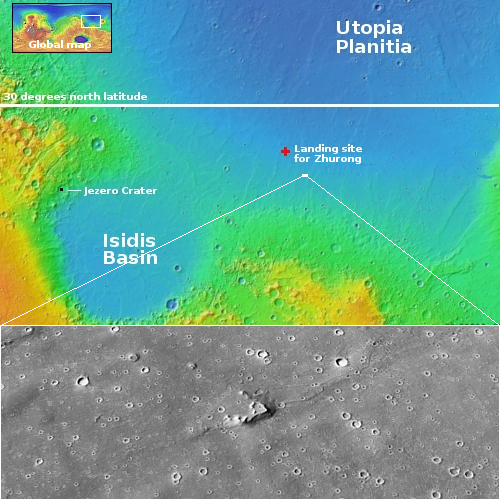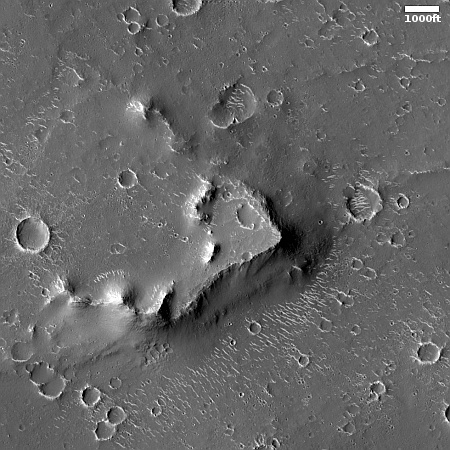A triangular Martian hill
Cool image time! The picture to the right, cropped, reduced, and sharpened to post here, was taken on May 29, 2023 by the high resolution camera on Mars Reconnaissance Orbiter (MRO). It shows what the science team labels an “unusual shaped hill” that is estimated to be about 20 to 40 feet high.
What makes it unusual? First, it sticks up out of the endless northern lowland plains for no obvious reason, though its shape suggests the existence of bedrock topography that is now buried by the dust and debris that coats the surface of those plains.
Second, the hill itself suggests that it formed after it was covered with debris. Note the crater near its northeast cliff. It appears that the cliff chopped off part of the crater, suggesting that the hill was once level with the surrounding terrain. Some later underground pressure pushed it upward, with its angled sides determined by existing faults.
Why those forces tilted the hill upward as it did, with only its eastern fringes raised, is a question a wide view might answer.

The overview map to the right marks this location with the white dot, southeast of where China’s Zhurong rover landed. The image below the map is a wider view of this hill, created from a mosaic of MRO context camera images.
Note the small ridge that lines up with the hill’s southeast cliff. Both suggest the existence of a larger faultline or crack, which reinforces the hypothesis that the hill was created when something pushed it up along fault lines. If so, this hill is thus a graben, which geologists define as either a depression or rise created when two masses of bedrock shift relative to each other along fault lines.
The many craters on this plain also tell us that the surface is very old. Little has happened over the eons to wipe clean the record of bombardment from the early solar system. That this unchanged terrain is also at 22 north latitude, in the dry equatorial regions, suggests that even as Mars made its regular swings of rotational tilt, from 11 to 60 degrees, producing hundreds of cycles of climate change, those cycles had relatively little impact here.
All suggestions and hints, but the data remains too sparse for any solid conclusions.
On Christmas Eve 1968 three Americans became the first humans to visit another world. What they did to celebrate was unexpected and profound, and will be remembered throughout all human history. Genesis: the Story of Apollo 8, Robert Zimmerman's classic history of humanity's first journey to another world, tells that story, and it is now available as both an ebook and an audiobook, both with a foreword by Valerie Anders and a new introduction by Robert Zimmerman.
The print edition can be purchased at Amazon or from any other book seller. If you want an autographed copy the price is $60 for the hardback and $45 for the paperback, plus $8 shipping for each. Go here for purchasing details. The ebook is available everywhere for $5.99 (before discount) at amazon, or direct from my ebook publisher, ebookit. If you buy it from ebookit you don't support the big tech companies and the author gets a bigger cut much sooner.
The audiobook is also available at all these vendors, and is also free with a 30-day trial membership to Audible.
"Not simply about one mission, [Genesis] is also the history of America's quest for the moon... Zimmerman has done a masterful job of tying disparate events together into a solid account of one of America's greatest human triumphs."--San Antonio Express-News
Cool image time! The picture to the right, cropped, reduced, and sharpened to post here, was taken on May 29, 2023 by the high resolution camera on Mars Reconnaissance Orbiter (MRO). It shows what the science team labels an “unusual shaped hill” that is estimated to be about 20 to 40 feet high.
What makes it unusual? First, it sticks up out of the endless northern lowland plains for no obvious reason, though its shape suggests the existence of bedrock topography that is now buried by the dust and debris that coats the surface of those plains.
Second, the hill itself suggests that it formed after it was covered with debris. Note the crater near its northeast cliff. It appears that the cliff chopped off part of the crater, suggesting that the hill was once level with the surrounding terrain. Some later underground pressure pushed it upward, with its angled sides determined by existing faults.
Why those forces tilted the hill upward as it did, with only its eastern fringes raised, is a question a wide view might answer.

The overview map to the right marks this location with the white dot, southeast of where China’s Zhurong rover landed. The image below the map is a wider view of this hill, created from a mosaic of MRO context camera images.
Note the small ridge that lines up with the hill’s southeast cliff. Both suggest the existence of a larger faultline or crack, which reinforces the hypothesis that the hill was created when something pushed it up along fault lines. If so, this hill is thus a graben, which geologists define as either a depression or rise created when two masses of bedrock shift relative to each other along fault lines.
The many craters on this plain also tell us that the surface is very old. Little has happened over the eons to wipe clean the record of bombardment from the early solar system. That this unchanged terrain is also at 22 north latitude, in the dry equatorial regions, suggests that even as Mars made its regular swings of rotational tilt, from 11 to 60 degrees, producing hundreds of cycles of climate change, those cycles had relatively little impact here.
All suggestions and hints, but the data remains too sparse for any solid conclusions.
On Christmas Eve 1968 three Americans became the first humans to visit another world. What they did to celebrate was unexpected and profound, and will be remembered throughout all human history. Genesis: the Story of Apollo 8, Robert Zimmerman's classic history of humanity's first journey to another world, tells that story, and it is now available as both an ebook and an audiobook, both with a foreword by Valerie Anders and a new introduction by Robert Zimmerman.
The print edition can be purchased at Amazon or from any other book seller. If you want an autographed copy the price is $60 for the hardback and $45 for the paperback, plus $8 shipping for each. Go here for purchasing details. The ebook is available everywhere for $5.99 (before discount) at amazon, or direct from my ebook publisher, ebookit. If you buy it from ebookit you don't support the big tech companies and the author gets a bigger cut much sooner.
The audiobook is also available at all these vendors, and is also free with a 30-day trial membership to Audible.
"Not simply about one mission, [Genesis] is also the history of America's quest for the moon... Zimmerman has done a masterful job of tying disparate events together into a solid account of one of America's greatest human triumphs."--San Antonio Express-News


